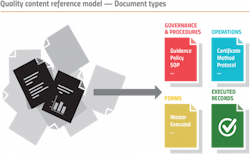The time for quality content standards is now
From master batch records to safety data sheets to basic training manuals, pharma manufacturers deal with an overwhelming amount of quality documentation. Different naming and categories for documents within organizations and across partners make content management even harder.
So it comes as no surprise that manufacturers have historically struggled to deploy, maintain and update legacy content management systems. By using systems without industry standards or best practices for content management, quality teams are burdened with complicated requirements definition and significant configuration and validation. The result is a system that is patched together and difficult to use, driving the adoption of non-validated tools like SharePoint and file shares to manage GxP content.
Legacy systems add complexity to quality processes and increase compliance risks, but there is positive change happening. We see a shift in the industry as more companies adopt modern quality content management solutions with built-in best practices to consolidate GxP and corporate governance content in one system.
In order to accelerate quality transformation, companies need to model their content management practice according to industry standards well in advance of technology implementation. Adopting a reference model with a standardized approach to content management can provide quality and document teams with a starting point to identify gaps in their content landscape, align stakeholders across various business functions, and create a strong foundation for harmonization across GxP domains.
For too long, the industry has struggled with lengthy requirements definition and complicated validation efforts. A widely accepted reference model can transform quality content management for the better. The time to consider quality content standards is now, and here is why.
Standardization drives alignment
Defining a content hierarchy and taxonomy is the first step in successfully implementing a content management system. But the time and cross-team collaboration it requires usually makes it challenging to complete, implement and uphold, leading to inconsistent taxonomy and significant compliance risk. For example, documents with incorrect data could be inaccessible during a remote audit or inspection.
Adopting a reference model with a standard approach for organizing and managing quality content across GxP domains streamlines content management and improves collaboration with partners, suppliers, and other key stakeholders. The reference model should provide a document hierarchy, taxonomy, and metadata to allow users to search, navigate and locate documents quickly and easily.
Companies with established standards can more effectively align stakeholders to reduce the effort and complexity in planning and preparation for system implementation. Quality content standards enable organizations to:
- Lower operational costs by streamlining configuration and validation
- Improve compliance and quality through consistent document structures
- Increase adoption with easy-to-use processes
- Improve collaboration by streamlining information sharing with third-party partners
- Drive continuous improvement across GxP domains
Standardization in quality will significantly streamline content management, just like the Drug Information Association’s TMF Reference Model transformed how the industry manages clinical documents. An industry-standard approach, based on proven best practices, can further simplify quality processes and accelerate execution.
Streamlining to enable speed
As companies begin their quality transformation journey, leveraging a reference model can drive consistency and speed. To apply a model successfully, consider three key areas that require standardization: document hierarchy, document types, and document lifecycles.
A document hierarchy allows users to associate documents to the appropriate lifecycle and organize them by relevant types and subtypes. The framework should align with document storage across the company. Using a standardized document hierarchy across the enterprise improves compliance readiness and cross-team collaboration.
Document types should be grouped to simplify mapping, minimize redundancies, and make it easier for users to search quality content. Organizing content into four groups, such as governance and procedures, operations, forms, and executed records, simplifies structure to streamline quality documents within a system.
Classifying content by lifecycle is equally important since quality content management systems are required to categorize documents by lifecycle stage, governed by industry regulations like 21 CFR parts 210 and 211.
Apply document lifecycles for content such as draft to effective, draft to approved, and initial to final, to simplify this process. Establishing standardized workflows for each lifecycle also helps accelerate reviews and approvals and streamlines SOPs and other GxP content sharing among all stakeholders.
By using a reference model to standardize quality content management, companies can accelerate system implementation and improve usability. Organizations can also drive alignment across the supply chain, enhancing collaboration with partners.
Delivering efficiencies across the supply chain
Companies that have adopted a content management system with a reference model and built-in best practices are successfully aligning stakeholders on document structure and taxonomy across the organization. These industry leaders are realizing significant benefits and are living proof that standardization works. Below are tips to consider when evaluating a content management solution, along with real-world examples from companies that have standardized quality content management.
Harmonize processes
With standards in place, harmonize processes to enable insights into who made changes to documents, what was changed, and why. This level of detail helps drive better issue resolution when challenges occur. Centralized content management processes also provide greater visibility to stakeholders, allowing for proactive quality management.
“We’ve been able to harmonize globally using a single system so that processes and document templates can be standardized,” says Cara Weyker, vice president, CMC Regulatory and Quality at Horizon Therapeutics. “This reduces the risk of errors or duplicated efforts.”
Keep all documents on one platform
Establish a single source for information to eliminate redundant records and simplify user access to documents, printing, and scanning. This reduces manual and paper-based processes and improves collaboration with partners. Providing stakeholders with secure access to records all in one place increases adherence to GxP practices and protocols.
“We’re using a quality document system with industry best practices built-in for compliant collaboration,” says Maria Conklin, director, Investigational Medicinal Product Quality at Karyopharm Therapeutics. “It makes the collaboration process much more efficient as we can easily find the correct version of documents uploaded by our vendors.”
Conduct periodic reviews
Apply automatic checks to keep systems aligned with the established standards and ensure consistency across all global content. Quality manufacturing spans many teams and organizations, and periodic reviews confirm adherence to quality standards. In addition, reviews help companies identify and address issues early on, improving compliance and inspection readiness.
“We needed to simplify key processes like documentation, end-user training, and change control,” says Sérgio Simões, vice president at Bluepharma. “We now have the quality systems in place to easily scale our manufacturing operations while maintaining compliance across stakeholders.”
Use a pre-validated system
Consider a quality content management system that provides access and authentication controls, role-based security and encryption, and enables risk-based strategies. With these capabilities in place, companies can ensure compliance throughout GxP processes. If you choose a cloud system that regularly adds new features and capabilities, ensure client support and comprehensive change management are offered to speed validation.
“We’re in the cell therapy space, and there are unique time restrictions we need to meet. These requirements challenge how we’ve traditionally managed training and communicated across functions,” says Javier Briceno, director of Quality Systems at Legend Biotech. “Adopting validated solutions built on one platform gave us the advantage of keeping up with change without sacrificing speed.”
Industry standards advance quality management
Legacy systems have complicated quality evidence requirements for years, slowing down operations. The good news is that organizations can eliminate inconsistent document management practices and lower compliance risks by adopting industry standards and best practices.
A quality content reference model can deliver the missing piece for content management, enabling companies to drive simplification and standardization across life sciences supply chains and beyond. Standards also help bring familiarity and a common language for content exchanges with contract partners, relationships that continue to become more critical in the delivery of innovations to patients.
The industry is at an inflection point where companies are replacing legacy systems with modern quality solutions. These systems deliver best practices and quality content standards out-of-the-box to help the industry move faster and more efficiently.
The shift is advancing quality management by aligning the industry on standards and best practices that work. As more companies adopt standards and apply them across their value chains, we’ll see a growing number of new treatments go to market faster.


